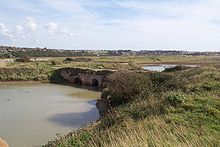| Revision as of 09:23, 10 November 2008 editBonadea (talk | contribs)Edit filter helpers, Autopatrolled, Extended confirmed users, Page movers, New page reviewers, Pending changes reviewers, Rollbackers151,774 editsm Reverted edits by Simon2239 (talk) to last version by Bonadea← Previous edit | Revision as of 09:26, 10 November 2008 edit undoSimon2239 (talk | contribs)191 edits Undid revision 250837393 by Bonadea (talk)Next edit → | ||
| Line 1: | Line 1: | ||
| {{Db-advert}} | |||
| {{infobox UK place | {{infobox UK place | ||
| |country = England | |country = England | ||
Revision as of 09:26, 10 November 2008
| This article may meet Misplaced Pages's criteria for speedy deletion because in its current form it serves only to promote or publicise an entity, person, product, or idea, and would require a fundamental rewrite in order to become encyclopedic. However, the mere fact that a company, organization, or product is a page's subject does not, on its own, qualify that page for deletion under this criterion. This criterion also does not apply where substantial encyclopedic content would remain after removing the promotional material as deletion is not cleanup; in this case please remove the promotional material yourself, or add the {{advert}} tag to alert others to do so. See CSD G11.%5B%5BWP%3ACSD%23G11%7CG11%5D%5D%3A+Unambiguous+%5B%5BWP%3ANOTADVERTISING%7Cadvertising%5D%5D+or+promotionG11
If this article does not meet the criteria for speedy deletion, or you intend to fix it, please remove this notice, but do not remove this notice from pages that you have created yourself. If you created this page and you disagree with the given reason for deletion, you can click the button below and leave a message explaining why you believe it should not be deleted. You can also visit the talk page to check if you have received a response to your message. Note that this article may be deleted at any time if it unquestionably meets the speedy deletion criteria, or if an explanation posted to the talk page is found to be insufficient.
Note to administrators: this article has content on its talk page which should be checked before deletion. Administrators: check links, talk, history (last), and logs before deletion. Consider checking Google.This page was last edited by Simon2239 (contribs | logs) at 09:26, 10 November 2008 (UTC) (16 years ago) |
| Tide Mills | |
|---|---|
| OS grid reference | TQ459002 |
| District | |
| Shire county | |
| Region | |
| Country | England |
| Sovereign state | United Kingdom |
| Police | Sussex |
| Fire | East Sussex |
| Ambulance | South East Coast |
| |


Tide Mills is a derelict village in East Sussex, England. It lies about 2 km southeast of Newhaven and 4 km northwest of Seaford and is near both Bishopstone and East Blatchington.
The old village
The village consisted of a large tide mill and numerous workers' cottages, housing about 100 workers. The tide mill at Bishopstone was erected in 1761 by the Duke of Newcastle, and was later owned and operated by William Catt (1770-1853) and his family.
The Sussex Archaeological Society started a long-term project in April 2006 to record the entire East Beach site: Mills, Railway Station, Nurses Home, Hospital, RNAS Station and the later holiday homes and the Marconi Radio station (1904). Apart from the dig, it will evolve into a huge collection of film, video, recollections and photographs logging the decline of the area.
The mill stopped in around 1900, the village was condemned as unfit for habitation in 1936 with the last residents forcibly removed in 1939. The area was in part cleared to give fields of fire and also used for street fighting training. The site was not used for target practice by Newhaven Fort Artillery, though this story is common locally.
The area accommodated vast numbers of Canadian troops during the Second World War.
There are the remains of a station on the Newhaven to Seaford line at grid reference TQ460003. It started life as either Bishopstone Station (the Victorian OS map of 1879 shows it as this together with a short branch line to the mills) or Tide Mills Halt, but became Bishopstone Beach Halt in 1939 before its closure in 1942. This is different from today's Bishopstone railway station at grid reference TV469998.
Mill complex

Old photographs and paintings, together with a poem show that the tide mill complex included a windmill.
Access
Access is either via Mill Drove, an insignificant single track road which runs south west from the Newhaven and Seaford roads at approximately the point where one changes into the other grid reference TQ463005 (very limited parking, and access is via a pedestrian railway crossing at Bishopstone Beach Halt); or along the beach to the east of Newhaven Harbour.
See also
References
- Bishopstone, the Largest Tide Mill in Sussex
- Newhaven Local & Maritime Museum - A Selection of Local Subjects
- The Sussex Archaeological Society Tide Mills archeology project
- Newhaven Local & Maritime Museum
- The train now standing at Bishopstone Beach
- Bishopstone Beach Halt station
- The Victorian OS map of 1879
- Source- plaques on the site for visitors
External links
- Friends of The Tidemills and Newhaven Eastside Conservation Group
- Corn. Bishopsten (sic), Sussex. Tide mills. Petition of merchants for sanction to build tide mills for grinding corn
- Outreach Helps to Turn the Tide
- Saline Lagoons The pound for the tide mill as a wildlife habitat
- Tidemills - a sustainable energy story